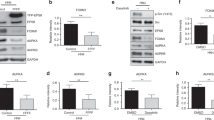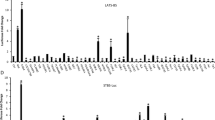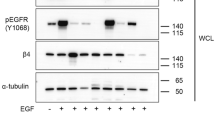Abstract
Receptor tyrosine kinases (RTKs) such as the fibroblast growth factor receptor (FGFR) and the epidermal growth factor receptor are overexpressed in a variety of cancers. In addition to overexpression, the FGFRs are found mutated in some cancers. The Src homology 2 domain-containing phosphotyrosine phosphatase (SHP2) is a critical mediator of RTK signaling, but its role in oncogenic RTK-induced cell transformation and cancer development is largely unknown. In the current report, we demonstrate that constitutively activated FGFR3 (K/E-FR3) transforms NIH-3T3 cells, and that SHP2 is a critical mediator of this transformation. Infection of K/E-FR3-transformed 3T3 cells with a retrovirus carrying a dominant-negative mutant of SHP2 (C/S-SHP2) retarded cell growth, reversed the transformation phenotype and inhibited focus-forming ability. Furthermore, treatment of K/E-FR3-transformed NIH-3T3 cells with PD98059 or LY294002, specific inhibitors of MEK and PI3K, respectively, inhibited focus formation. Biochemical analysis showed that K/E-FR3 activates the Ras-ERK and the PI3K signaling pathways, and that the C/S SHP2 mutant suppressed this effect via competitive displacement of interaction of the endogenous SHP2 with FRS2. However, the C/S SHP2 protein did not show any effect on receptor autophosphorylation, FRS2 tyrosine phosphorylation or interaction of Grb2 with K/E-FR3 or FRS2. Together, the results show that K/E-FR3 is transforming and that the Ras-ERK and the PI3K-Akt signaling pathways, which are positively regulated by SHP2, are important for K/E-FR3-induced transformation.
This is a preview of subscription content, access via your institution
Access options
Subscribe to this journal
Receive 50 print issues and online access
$259.00 per year
only $5.18 per issue
Buy this article
- Purchase on Springer Link
- Instant access to full article PDF
Prices may be subject to local taxes which are calculated during checkout








Similar content being viewed by others
References
Agazie Y, Ischenko I and Hayman M . (2002). Oncogene, 21, 697–707.
Agazie YM and Hayman MJ . (2003). J. Biol. Chem., 278, 13952–13958.
Anderson J, Burns HD, Enriquez-Harris P, Wilkie AO and Heath JK . (1998). Hum. Mol. Genet., 7, 1475–1483.
Bellus GA, Spector EB, Speiser PW, Weaver CA, Garber AT, Bryke CR, Israel J, Rosengren SS, Webster MK, Donoghue DJ and Francomano CA . (2000). Am. J. Hum. Genet., 67, 1411–1421.
Chesi M, Bergsagel PL and Kuehl WM . (2002). Curr. Opin. Hematol., 9, 288–293.
Chesi M, Brents LA, Ely SA, Bais C, Robbiani DF, Mesri EA, Kuehl WM and Bergsagel PL . (2001). Blood, 97, 729–736.
Chesi M, Nardini E, Brents LA, Schrock E, Ried T, Kuehl WM and Bergsagel PL . (1997). Nat. Genet., 16, 260–264.
Deb TB, Wong L, Salomon DS, Zhou G, Dixon JE, Gutkind JS, Thompson SA and Johnson GR . (1998). J. Biol. Chem., 273, 16643–16646.
Denu JM, Zhou G, Guo Y and Dixon JE . (1995). Biochemistry, 34, 3396–3403.
Dickson C, Spencer-Dene B, Dillon C and Fantl V . (2000). Breast Cancer Res., 2, 191–196.
Feng GS, Hui CC and Pawson T . (1993). Science, 259, 1607–1611.
Feng GS and Pawson T . (1994). Trends Genet, 10, 54–58.
Feng GS, Shen R, Heng HH, Tsui LC, Kazlauskas A and Pawson T . (1994). Oncogene, 9, 1545–1550.
Hadari YR, Kouhara H, Lax I and Schlessinger J . (1998). Mol. Cell. Biol., 18, 3966–3973.
Hakak Y, Hsu YS and Martin GS . (2000). Oncogene, 19, 3164–3171.
Hallek M, Bergsagel PL and Anderson KC . (1998). Blood, 91, 3–21.
Hart KC, Robertson SC and Donoghue DJ . (2001). Mol. Biol. Cell, 12, 931–942.
Hart KC, Robertson SC, Kanemitsu MY, Meyer AN, Tynan JA and Donoghue DJ . (2000). Oncogene, 19, 3309–3320.
Iseki S, Wilkie AO, Heath JK, Ishimaru T, Eto K and Morriss-Kay GM . (1997). Development, 124, 3375–3384.
Jang JH, Shin KH and Park JG . (2001). Cancer Res., 61, 3541–3543.
Jaye M, Schlessinger J and Dionne CA . (1992). Biochim. Biophys. Acta., 1135, 185–199.
Johnson DE and Williams LT . (1993). Adv. Cancer Res., 60, 1–41.
Lax I, Wong A, Lamothe B, Lee A, Frost A, Hawes J and Schlessinger J . (2002). Mol. Cell, 10, 709–719.
Legeai-Mallet L, Benoist-Lasselin C, Delezoide AL, Munnich A and Bonaventure J . (1998). J. Biol. Chem., 273, 13007–13014.
Li C, Chen L, Iwata T, Kitagawa M, Fu XY and Deng CX . (1999). Hum. Mol. Genet., 8, 35–44.
Li Y, Mangasarian K, Mansukhani A and Basilico C . (1997). Oncogene, 14, 1397–1406.
Lin HY, Xu J, Ornitz DM, Halegoua S and Hayman MJ . (1996). J. Neurosci., 16, 4579–4587.
Melillo RM, Santoro M, Ong SH, Billaud M, Fusco A, Hadari YR, Schlessinger J and Lax I . (2001). Mol. Cell. Biol., 21, 4177–4187.
Monsonego-Ornan E, Adar R, Feferman T, Segev O and Yayon A . (2000). Mol. Cell. Biol., 20, 516–522.
Neilson KM and Friesel R . (1996). J. Biol. Chem., 271, 25049–25057.
Ong SH, Guy GR, Hadari YR, Laks S, Gotoh N, Schlessinger J and Lax I . (2000). Mol. Cell. Biol., 20, 979–989.
O'Reilly AM, Pluskey S, Shoelson SE and Neel BG . (2000). Mol. Cell. Biol., 20, 299–311.
Ornitz DM, Xu J, Colvin JS, McEwen DG, MacArthur CA, Coulier F, Gao G and Goldfarb M . (1996). J. Biol. Chem., 271, 15292–15297.
Park CY and Hayman MJ . (1999). J. Biol. Chem., 274, 7583–7590.
Partanen J, Armstrong E, Makela TP, Korhonen J, Sandberg M, Renkonen R, Knuutila S, Huebner K and Alitalo K . (1992). Mol. Cell. Biol., 12, 1698–1707.
Plotnikov AN, Schlessinger J, Hubbard SR and Mohammadi M . (1999). Cell, 98, 641–650.
Plowright EE, Li Z, Bergsagel PL, Chesi M, Barber DL, Branch DR, Hawley RG and Stewart AK . (2000). Blood, 95, 992–998.
Richelda R, Ronchetti D, Baldini L, Cro L, Viggiano L, Marzella R, Rocchi M, Otsuki T, Lombardi L, Maiolo AT and Neri A . (1997). Blood, 90, 4062–4070.
Robertson SC, Meyer AN, Hart KC, Galvin BD, Webster MK and Donoghue DJ . (1998). Proc. Natl. Acad. Sci. USA, 95, 4567–4572.
Rousseau F, el Ghouzzi V, Delezoide AL, Legeai-Mallet L, Le Merrer M, Munnich A and Bonaventure J . (1996). Hum. Mol. Genet., 5, 509–512.
Saxton TM, Ciruna BG, Holmyard D, Kulkarni S, Harpal K, Rossant J and Pawson T . (2000). Nat. Genet., 24, 420–423.
Saxton TM, Henkemeyer M, Gasca S, Shen R, Rossi DJ, Shalaby F, Feng GS and Pawson T . (1997). EMBO J., 16, 2352–2364.
Shi ZQ, Yu DH, Park M, Marshall M and Feng GS . (2000). Mol. Cell. Biol., 20, 1526–1536.
Tavormina PL, Bellus GA, Webster MK, Bamshad MJ, Fraley AE, McIntosh I, Szabo J, Jiang W, Jabs EW, Wilcox WR, Wasmuth JJ, Donoghue DJ, Thompson LM and Francomano CA . (1999). Am. J. Hum. Genet., 64, 722–731.
Taylor SJ and Shalloway D . (1996). Curr. Biol., 6, 1621–1627.
Ueki T, Koji T, Tamiya S, Nakane PK and Tsuneyoshi M . (1995). J. Pathol., 177, 353–361.
Van Rhijn BW, Van Tilborg AA, Lurkin I, Bonaventure J, De Vries A, Thiery JP, Van Der Kwast TH, Zwarthoff EG and Radvanyi F . (2002). Eur. J. Hum. Genet., 10, 819–824.
Van Vactor D, O'Reilly AM and Neel BG . (1998). Curr. Opin. Genet. Dev., 8, 112–126.
Webster MK and Donoghue DJ . (1997a). Mol. Cell. Biol., 17, 5739–5747.
Webster MK and Donoghue DJ . (1997b). Trends Genet., 13, 178–182.
Wilkie AO and Goodacre TE . (1997). Am. J. Med. Genet., 69, 433–434.
Wilkie AO and Morriss-Kay GM . (2001). Nat. Rev. Genet., 2, 458–468.
Wilkie AO, Slaney SF, Oldridge M, Poole MD, Ashworth GJ, Hockley AD, Hayward RD, David DJ, Pulleyn LJ and Rutland P . et al . (1995a). Nat. Genet., 9, 165–172.
Wilkie AO and Wall SA . (1996). Curr. Opin. Neurol., 9, 146–152.
Wilkie AO, Yang SP, Summers D, Poole MD, Reardon W and Winter RM . (1995b). J. Med. Genet., 32, 174–180.
Winterpacht A, Hilbert K, Stelzer C, Schweikardt T, Decker H, Segerer H, Spranger J and Zabel B . (2000). Physiol. Genomics, 2, 9–12.
Xu H, Lee KW and Goldfarb M . (1998). J. Biol. Chem., 273, 17987–17990.
Acknowledgements
We thank Dr Shalloway and Dr Petrenko for their provision of valuable reagents. This work was supported by NIH Public Service Grants CA28146 and CA42573 to MJH.
Author information
Authors and Affiliations
Corresponding author
Rights and permissions
About this article
Cite this article
Agazie, Y., Movilla, N., Ischenko, I. et al. The phosphotyrosine phosphatase SHP2 is a critical mediator of transformation induced by the oncogenic fibroblast growth factor receptor 3. Oncogene 22, 6909–6918 (2003). https://doi.org/10.1038/sj.onc.1206798
Received:
Revised:
Accepted:
Published:
Issue Date:
DOI: https://doi.org/10.1038/sj.onc.1206798
Keywords
This article is cited by
-
Integrated in silico MS-based phosphoproteomics and network enrichment analysis of RASopathy proteins
Orphanet Journal of Rare Diseases (2021)
-
Identification of genomic aberrations in hemangioblastoma by droplet digital PCR and SNP microarray highlights novel candidate genes and pathways for pathogenesis
BMC Genomics (2016)
-
Inhibition of SHP2 in basal-like and triple-negative breast cells induces basal-to-luminal transition, hormone dependency, and sensitivity to anti-hormone treatment
BMC Cancer (2015)
-
HER2 stabilizes EGFR and itself by altering autophosphorylation patterns in a manner that overcomes regulatory mechanisms and promotes proliferative and transformation signaling
Oncogene (2013)
-
The Eyes Absent phosphatase-transactivator proteins promote proliferation, transformation, migration, and invasion of tumor cells
Oncogene (2010)



